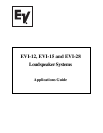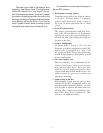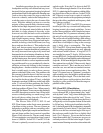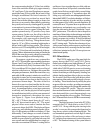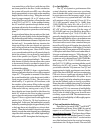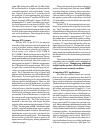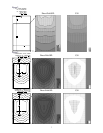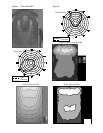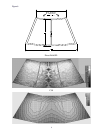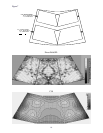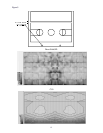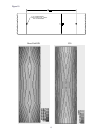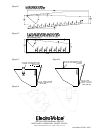2
Installation procedures for any conventional
loudspeaker are fairly well-defined and easy to un-
derstand: find an appropriate hanging height and
position that affords a clear path to the listening area
(such as above the center of a stage or above the
lectern in a church), and aim the loudspeaker to-
wards the center or just to the rear of center of the
room. With this method you hope to cover the
majority of the room with fairly consistent sound,
but the mid and high frequencies never seem to fill
perfectly. It is frequently aimed a little too far back
and there is a large amount of slap echo, or the
front row is too loud, the back row too soft and the
front and back row corners sound muted due to a
lack of high-frequency energy. Other solutions to
filling the room have been suggested and imple-
mented, including a dual-horn format (one long
throw and one short throw). This method works
fairly well, but encounters several problems: the
added expense of another horn/driver combination;
the vastly increased time to physically install and
then tune the level and aiming of two horns; the in-
evitable destructive interference patterns through-
out the listening area; the expense of another ampli-
fier channel to achieve correct impedance match-
ing; and the need for a very aesthetically clean in-
stallation, with no odd-looking (to the customer)
dangling horns. Another solution is to have a horn
that is variable angle, in order to throw a narrow
pattern to the back of the room. The problem with
this concept is that this doesn’t take into account
the drop in SPL between the near throw (about 25
feet) and the far throw (about 70 feet), so the high
frequencies are about 10 dB down in the back of the
room. To solve all of these problems, the Vari In-
tense
®
horns were invented, yet another innovation
in the long tradition of Electro-Voice. When properly
aimed, the Vari Intense
®
horns can provide extremely
even SPL throughout an entire room, filling in the
corners without pushing too much energy at the
back wall, thus avoiding slap echo. The rules of
fixed installation have just changed...
The Electro-Voice EVI-12, EVI-15 and
EVI-28 enclosures are the first in a new generation
of problem-solving systems. The new systems are
designed as a package, with easy mounting, refin-
ishing ability, lightweight, compact and unobtrusive
size and shape and the classic musical sound that
Electro-Voice is known for. The new small-format
VI horn maintains consistent directional control
down to 2,000 Hz. In the EVI-12 and EVI-15 the
VI horn is optimally crossed over to an specially
angled woofer. Note: the 12-in. driver in the EVI-
12 is at a different angle than the 15-in. driver in the
EVI-15, optimizing the floor pattern with the differ-
ing directivities of the two drivers. In the EVI-28,
the VI horn is crossed over to a pair of vertically-
arrayed 8-inch woofers with a proprietary technique
that provides delay, amplitude and frequency shad-
ing to the two woofers.
The EVI-12, EVI-15 and EVI-28 systems are
installed just like any conventional loudspeaker,
keeping in mind a few simple guidelines. Let me
preface these guidelines with a simple but impor-
tant comment: the VI systems are extremely versa-
tile and will work in a large variety of applications.
They will work well with tall ceilings, short ceilings,
rectangular rooms, slightly trapezoidal rooms and a
whole host of odd shapes so long as the coverage
area is fairly close to rectangular. The larger
EVI-12 and EVI-15 have been tested in rooms with
12-foot ceilings and performed very well, although
with reduced width of throw. A single EVI-12
was installed in a room 75-foot by 150-foot and an
average RT60 of 4.5 in the mid band and performed
very well with good intelligibility and a minimum of
slap echo. It has been thought in the past that if the
floor pattern does not fit the VI horn exactly, then it
cannot be used at all. This is not the case, and if it
were the case, we could not use standard constant-
directivity horns in most applications either. The
larger VI systems have an “optimum” room that is
approximately twice the height in width and three
times the height in length. This is the ideal condi-
tion, but the figures and descriptions that follow
should give you a good feel for the wide-range ca-
pabilities of the systems.
EVI-12 and EVI-15 Installation:
The nominal floorplan that the system will
cover with equal SPL is approximately two “units”
wide by three “units” long, where the height of the
loudspeaker defines the size of the “unit.” For ex-
ample, if the loudspeaker is 18 feet above the floor, it
will typically cover a floorplan of about 36 feet wide
by 54 feet long. In this typical installation (see Fig-
ure 1), the back panel of the loudspeaker is mounted
approximately 0.6 units (about 11 feet) back from
the first row and has a nominal angle of the top of
the enclosure parallel to the floor or slightly tilted
back (2 to 3 degrees). For rooms that are much
longer than normal, the VI systems are very easy to
aim and position to fill the entire length. Experi-
ments in actual listening rooms have shown that with



